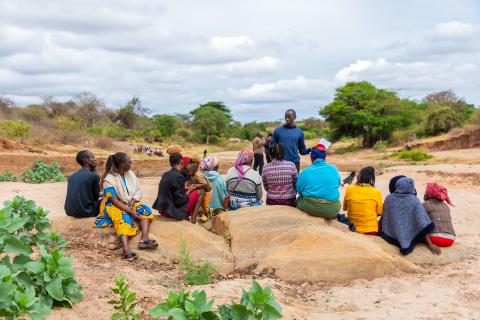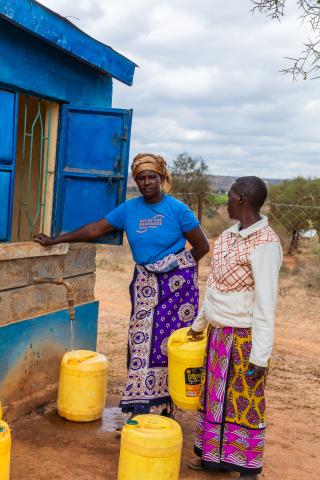Africa is painted grey: Building Africa’s evidence base of readily available data
Africa is painted grey: Building Africa’s evidence base of readily available data
At the launch of the Locally-Led Adaptation Metrics for Africa (LAMA) project, in Kisumu, Kenya, Professor Cromwel Lukorito (Vice Chair, Intergovernmental Panel on Climate Change) outlined what he described as a major challenge for local climate adaptation in Africa. Cromwel told the audience, “Africa is painted grey”, referring to the lack of readily available, up-to-date and disaggregated data from the continent.
Consider, for example, the indicators reflecting the continent's progress towards the Sustainable Development Goals (SDGs). In the global map below, indicators are shown for access to water - this is reflected in SDG6. Many African countries are marked by grey diagonal lines, with the key displaying “no data” for these countries. These data gaps can have a significant impact at both local and national scales. For example, in Kenya, small-scale farmers have to pay increased premiums for crop insurance products because of insufficient data detailing the potential climate impacts on their farms.
Furthermore, while climate finance is available to support adaptation, there is currently insufficient data to motivate where the funding should go and why. Rory Hunter, from the World Resources Institute, argues that adaptation projects implementing nature-based solutions rarely collect the data which could demonstrate the benefits of their interventions, often because of a lack of long-term financing. Cromwel argues that “We need to develop an evidence base to demand funding from the Global Climate Finance Facility, as opposed to just asking for it”. The challenge that adaptation projects face is daunting: how to support contextually-responsive local adaptation action that responds to the needs of marginalised and vulnerable communities while at the same time linking these local adaptation actions with standardised national and global metrics that allow governments and funders to make better decisions.
“A smallholder farmer may not understand what greenhouse effect is, but he/she for sure needs what it achievable and a comfortable planet for us all” -
Mr Josphat Omune, Chairman, Grassroots Impact Centre, Sondu, LREB region, Kenya
Initiatives in Kenya focus on co-developing local metrics
In Kenya, two initiatives are linking local metrics to national and global objectives: the governance and functionality study of county climate fund investments, led by CDKN, and the LAMA project, led by the Africa Research and Impact Network (ARIN). These two initiatives share a common thread: the US$ 251m Financing Locally Led Climate Action (FLLOCA) programme. This programme has provided the funding for the county climate funds and has acknowledged the LAMA project among LLA metrics stakeholders in Kenya.

The county climate change funds have made investments in more than 50 small-scale water infrastructure sites across Kenya. These innovative investments are managed by local water committees and support local-adaptation, ecosystem-based approaches including sand dams, earth dams and rock catchments. CDKN is supporting the monitoring and evaluation of this work, which has accumulated in a national learning event with county governments. The Makueni County governor highlighted the importance of evaluating these investments to demonstrate how they are enabling access to fresh water. This evaluation included engineers travelling to the various sites to assess whether the water points are functional. They also interviewed community members to assess how the water is being used. The governor has requested that the location and impact of the investment sites be mapped for the county government so that he can see what progress is being made. He highlighted that by improving access to clean water, these investments are allowing people to grow more food, improving incomes and food security, and can also reduce the risk of sickness among the smallholder families.
Similarly, in the Lake Victoria region of Kenya, the LAMA project is co-developing metrics with local farmer groups. These metrics are being designed to account for the lived realities of different marginalised groups, including women, children, indigenous communities, people living with disabilities, and minorities residing within local settings, especially as they experience the impacts of both droughts and floods which are becoming common in the region. Dr Wilberforce Ottichilo (Governor of County Government of Vihiga & Chair of Climate Change at the Council of Governors & LREB region) underscored how important it is to co-develop relevant tools, data and information when he commented, “We appreciate this project is unique because it puts the local communities at the centre of decision making right from inception. It also begins with a scientific inquiry that could unearth existing barriers to progress that could otherwise be overlooked.”
Using localised data to build an evidence base
So how does this work begin to address some of the data gaps at local, national and continental levels? Data can become powerful evidence for justifying additional adaptation funding if the right questions are asked and answers gathered.
One focus of CDKN’s evaluation of these county climate change fund investments was assessing how much each site had improved water access. In addition to assessing water quality, local communities were asked, “How many people live within 1 km of the water point?” This is a key indicator of water access. The gathered data not only indicates how many people have improved access to water as a result of the investments, but can also be used to help justify requests for additional funding for the county climate change funds.

The LAMA project has recognised the importance of gathering locally-relevant data and using it to inform national and even global processes. The metrics that they are developing and measuring will feed into the Kenyan subnational reporting framework, which informs the national adaptation reporting to the United Nations Framework Convention on Climate Change and the Global Goal on Adaptation.
The LAMA project highlights the value of developing metrics that not only reflect community-level adaptation actions and needs, but also reflect the diversity within communities. The CDKN evaluation of the county climate change fund investments show how monitoring and evaluation of local actions can link with national and even global processes. Both initiatives are linking local contexts, priorities and adaptation actions to national and global objectives and demonstrate how responding to the climate crisis is built upon the actions of diverse local actors. Organisations supporting adaptation action at all levels need to consider how their monitoring and evaluation responds to both local priorities and national and global goals. When these connections are made, local organisations can produce the evidence required to justify funding from global climate finance organisations, and begin accurately painting the continent.
